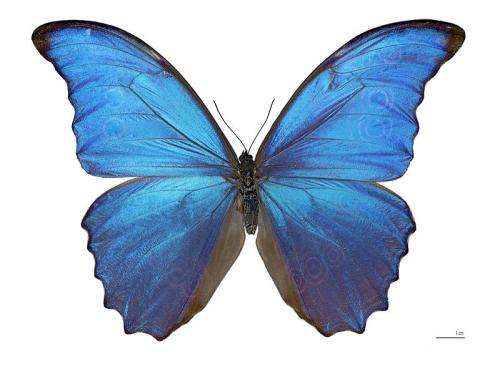Butterfly wings inspire new technologies: from fabrics and cosmetics to sensors

A new study has revealed that the stunning iridescent wings of the tropical blue Morpho butterfly could expand the range of innovative technologies. Scientific lessons learnt from these butterflies have already inspired designs of new displays, fabrics and cosmetics.
Now research by the University of Exeter, in collaboration with General Electric (GE) Global Research Centre, University at Albany and Air Force Research Laboratory, and funded by the US Defense Advanced Research Projects Agency (DARPA), has discovered that the physical structure and surface chemistry of the Morpho butterfly's wings provides surprising properties that could offer a variety of applications ranging from photonic security tags to self cleaning surfaces and protective clothing and to industrial sensors.
Tiny tree-like nanostructures on the scales of Morpho wings are known to be responsible for the butterfly's brilliant metallic blue iridescence. The study, published in the journal PNAS, found that vapour molecules adhere differently to the tops of these structures than to the bottom. This selective response to vapour molecules is the key to the range of possible bio-inspired technological applications.
Dr Radislav Potyrailo, from GE, who is the Principal Investigator on this DARPA Program, said: "Our interdisciplinary team of physicists, chemists, biologist, and materials scientists was able to unveil the existence of surface polarity gradient on iridescent Morpho butterfly scales. This discovery further allowed us to bring a multivariable perspective for vapour sensing, where selectivity is achieved within a single chemically graded nanostructured sensing unit, rather than from an array of separate sensors".
Professor Pete Vukusic from the University of Exeter said: "Understanding iridescence in butterflies and moths has revolutionised our knowledge of natural photonics. By using design ideas from nature we are able to work towards the development of applications in a range of different technologies. In this study the team discovered a new mechanism in photonic vapour sensing that demonstrates combined physical and chemical effects on the nanoscale."
Although not essential for butterfly survival, this unique property of selective gas adsorption is a by-product of the process of butterfly wing scale development.
More information: Discovery of the surface polarity gradient on iridescent Morpho butterfly scales reveals a mechanism of their selective vapor response, www.pnas.org/cgi/doi/10.1073/pnas.1311196110
Journal information: Proceedings of the National Academy of Sciences
Provided by University of Exeter



















